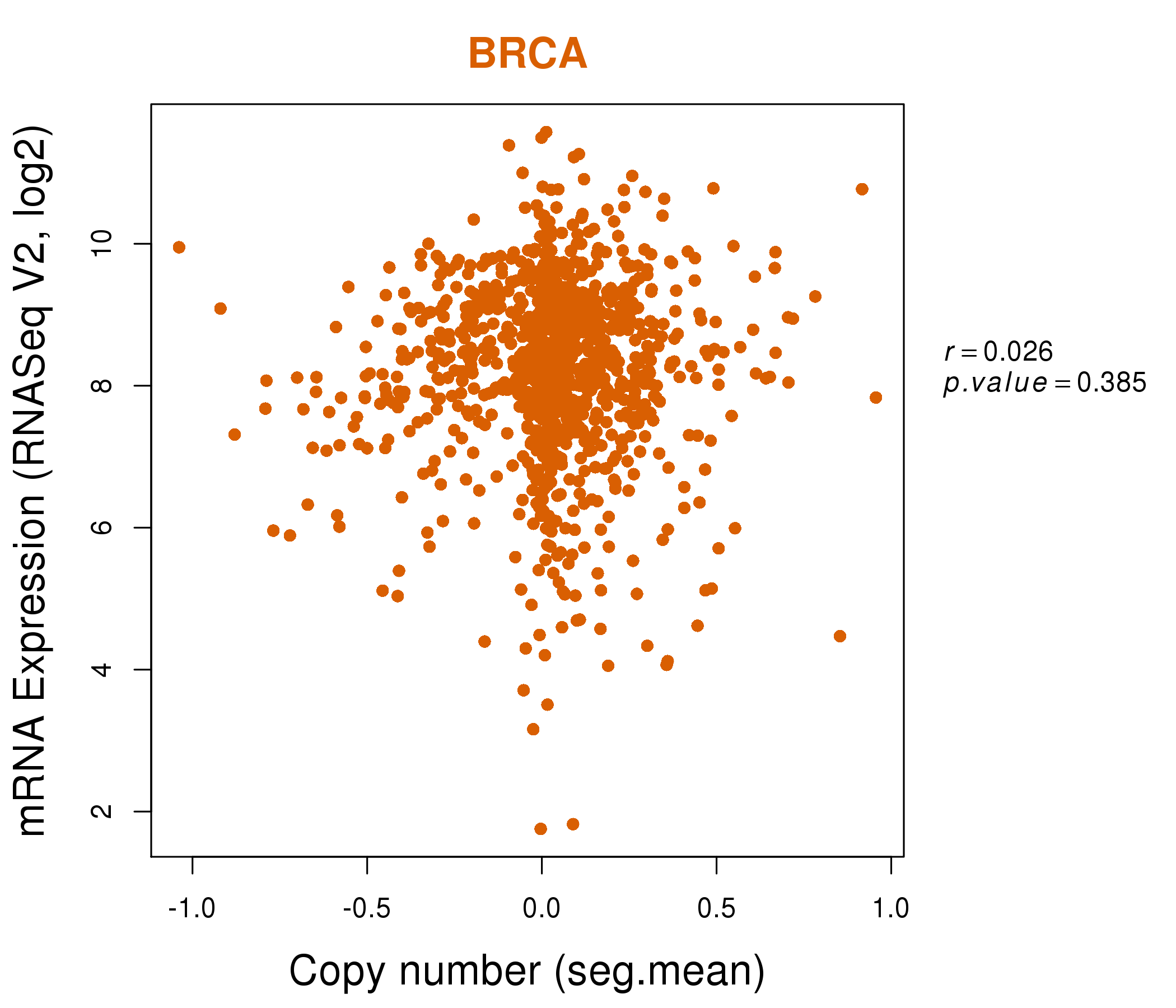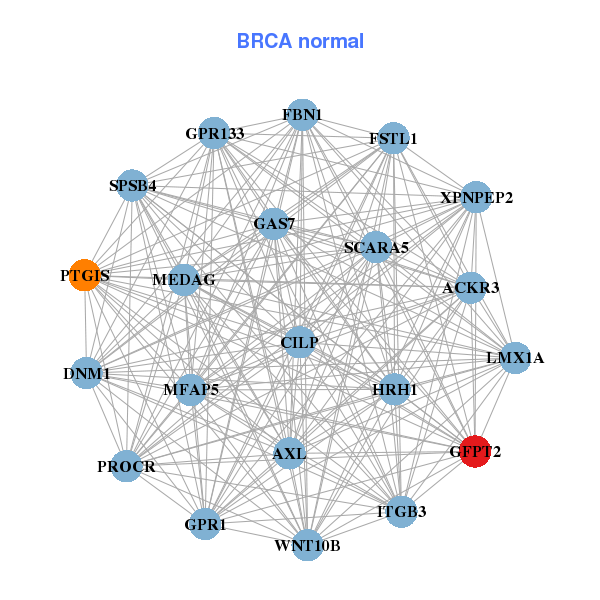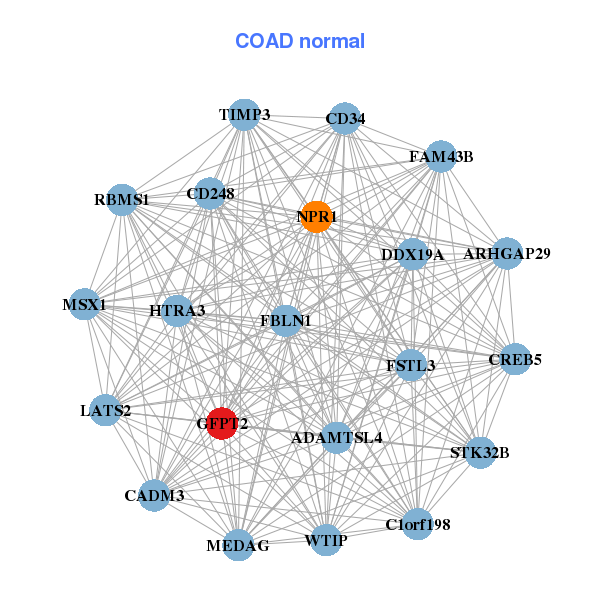|
||||||||||||||||||||||||||||||||||||||||||||||||||||||||||||||||||||||||||||||||||||||||||||||||||||||||||||||||||||||||||||||||||||||||||||||||||||||||||||||||||||||||||||||||||||||||||||||||||||||||||||||||||||||||||||||||||||||||||||||||||||||||||||||||||||||||||||||||||||||||||||||||||||||||||||||||||||||||||
| |
| Phenotypic Information (metabolism pathway, cancer, disease, phenome) |
| |
| |
| Gene-Gene Network Information: Co-Expression Network, Interacting Genes & KEGG |
| |
|
| Gene Summary for GFPT2 |
| Basic gene info. | Gene symbol | GFPT2 |
| Gene name | glutamine-fructose-6-phosphate transaminase 2 | |
| Synonyms | GFAT2 | |
| Cytomap | UCSC genome browser: 5q34-q35 | |
| Genomic location | chr5 :179727699-179780315 | |
| Type of gene | protein-coding | |
| RefGenes | NM_005110.2, | |
| Ensembl id | ENSG00000131459 | |
| Description | D-fructose-6-phosphate amidotransferase 2GFAT 2glucosamine--fructose-6-phosphate aminotransferase [isomerizing] 2glutamine--fructose-6-phosphate aminotransferase [isomerizing] 2glutamine: fructose-6-phosphate aminotransferase 2glutamine:fructose 6 ph | |
| Modification date | 20141207 | |
| dbXrefs | MIM : 603865 | |
| HGNC : HGNC | ||
| Ensembl : ENSG00000131459 | ||
| HPRD : 04842 | ||
| Vega : OTTHUMG00000163442 | ||
| Protein | UniProt: go to UniProt's Cross Reference DB Table | |
| Expression | CleanEX: HS_GFPT2 | |
| BioGPS: 9945 | ||
| Gene Expression Atlas: ENSG00000131459 | ||
| The Human Protein Atlas: ENSG00000131459 | ||
| Pathway | NCI Pathway Interaction Database: GFPT2 | |
| KEGG: GFPT2 | ||
| REACTOME: GFPT2 | ||
| ConsensusPathDB | ||
| Pathway Commons: GFPT2 | ||
| Metabolism | MetaCyc: GFPT2 | |
| HUMANCyc: GFPT2 | ||
| Regulation | Ensembl's Regulation: ENSG00000131459 | |
| miRBase: chr5 :179,727,699-179,780,315 | ||
| TargetScan: NM_005110 | ||
| cisRED: ENSG00000131459 | ||
| Context | iHOP: GFPT2 | |
| cancer metabolism search in PubMed: GFPT2 | ||
| UCL Cancer Institute: GFPT2 | ||
| Assigned class in ccmGDB | C | |
| Top |
| Phenotypic Information for GFPT2(metabolism pathway, cancer, disease, phenome) |
| Cancer | CGAP: GFPT2 |
| Familial Cancer Database: GFPT2 | |
| * This gene is included in those cancer gene databases. |
|
|
|
|
|
|
| ||||||||||||||||||||||||||||||||||||||||||||||||||||||||||||||||||||||||||||||||||||||||||||||||||||||||||||||||||||||||||||||||||||||||||||||||||||||||||||||||||||||||||||||||||||||||||||||||||||||||||||||||||||||||||||||||||||||||||||||||||||||||||||||||||||||||||||||||||||||||||||||||||||||||||||||||||||
Oncogene 1 | Significant driver gene in | |||||||||||||||||||||||||||||||||||||||||||||||||||||||||||||||||||||||||||||||||||||||||||||||||||||||||||||||||||||||||||||||||||||||||||||||||||||||||||||||||||||||||||||||||||||||||||||||||||||||||||||||||||||||||||||||||||||||||||||||||||||||||||||||||||||||||||||||||||||||||||||||||||||||||||||||||||||||||
| cf) number; DB name 1 Oncogene; http://nar.oxfordjournals.org/content/35/suppl_1/D721.long, 2 Tumor Suppressor gene; https://bioinfo.uth.edu/TSGene/, 3 Cancer Gene Census; http://www.nature.com/nrc/journal/v4/n3/abs/nrc1299.html, 4 CancerGenes; http://nar.oxfordjournals.org/content/35/suppl_1/D721.long, 5 Network of Cancer Gene; http://ncg.kcl.ac.uk/index.php, 1Therapeutic Vulnerabilities in Cancer; http://cbio.mskcc.org/cancergenomics/statius/ |
| KEGG_ALANINE_ASPARTATE_AND_GLUTAMATE_METABOLISM KEGG_AMINO_SUGAR_AND_NUCLEOTIDE_SUGAR_METABOLISM REACTOME_METABOLISM_OF_PROTEINS | |
| OMIM | |
| Orphanet | |
| Disease | KEGG Disease: GFPT2 |
| MedGen: GFPT2 (Human Medical Genetics with Condition) | |
| ClinVar: GFPT2 | |
| Phenotype | MGI: GFPT2 (International Mouse Phenotyping Consortium) |
| PhenomicDB: GFPT2 | |
| Mutations for GFPT2 |
| * Under tables are showing count per each tissue to give us broad intuition about tissue specific mutation patterns.You can go to the detailed page for each mutation database's web site. |
| - Statistics for Tissue and Mutation type | Top |
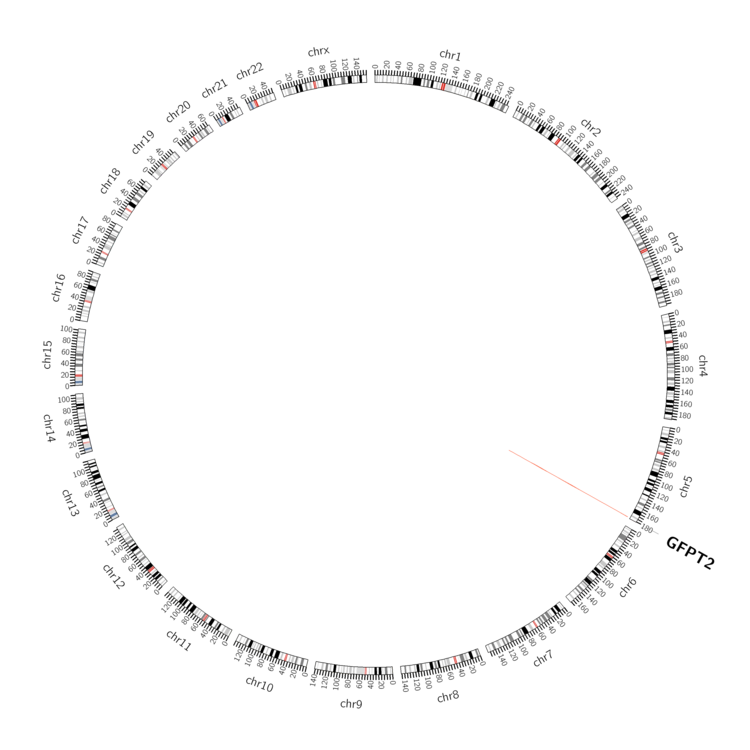 |
| - For Inter-chromosomal Variations |
| There's no inter-chromosomal structural variation. |
| - For Intra-chromosomal Variations |
| * Intra-chromosomal variantions includes 'intrachromosomal amplicon to amplicon', 'intrachromosomal amplicon to non-amplified dna', 'intrachromosomal deletion', 'intrachromosomal fold-back inversion', 'intrachromosomal inversion', 'intrachromosomal tandem duplication', 'Intrachromosomal unknown type', 'intrachromosomal with inverted orientation', 'intrachromosomal with non-inverted orientation'. |
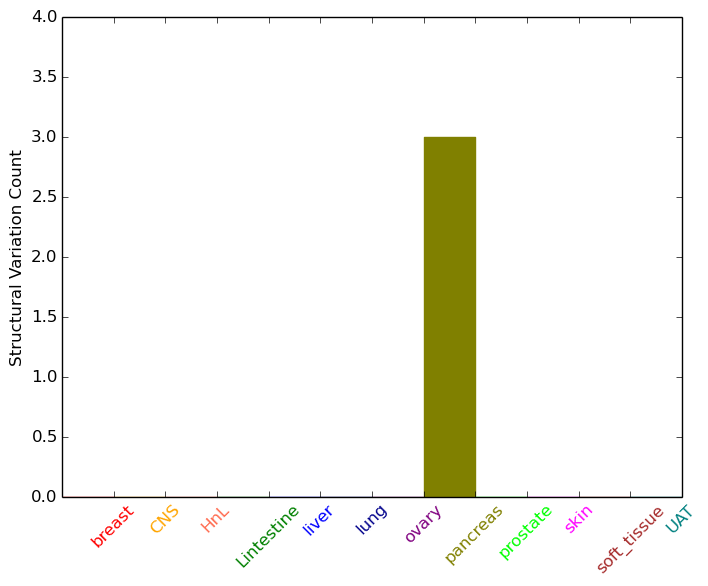 |
| Sample | Symbol_a | Chr_a | Start_a | End_a | Symbol_b | Chr_b | Start_b | End_b |
| pancreas | GFPT2 | chr5 | 179751827 | 179751847 | GFPT2 | chr5 | 179755052 | 179755072 |
| pancreas | GFPT2 | chr5 | 179762681 | 179762701 | chr5 | 179805364 | 179805384 | |
| pancreas | GFPT2 | chr5 | 179763363 | 179763383 | chr5 | 179638056 | 179638076 |
| cf) Tissue number; Tissue name (1;Breast, 2;Central_nervous_system, 3;Haematopoietic_and_lymphoid_tissue, 4;Large_intestine, 5;Liver, 6;Lung, 7;Ovary, 8;Pancreas, 9;Prostate, 10;Skin, 11;Soft_tissue, 12;Upper_aerodigestive_tract) |
| * From mRNA Sanger sequences, Chitars2.0 arranged chimeric transcripts. This table shows GFPT2 related fusion information. |
| ID | Head Gene | Tail Gene | Accession | Gene_a | qStart_a | qEnd_a | Chromosome_a | tStart_a | tEnd_a | Gene_a | qStart_a | qEnd_a | Chromosome_a | tStart_a | tEnd_a |
| AW867731 | GFPT2 | 37 | 221 | 5 | 179727919 | 179728102 | GFPT2 | 220 | 363 | 5 | 179727749 | 179727892 | |
| BE841311 | GFPT2 | 2 | 175 | 5 | 179727929 | 179728102 | GFPT2 | 174 | 317 | 5 | 179727749 | 179727892 | |
| BE841297 | GFPT2 | 15 | 160 | 5 | 179727749 | 179727892 | GFPT2 | 159 | 348 | 5 | 179727913 | 179728102 | |
| AW867686 | GFPT2 | 18 | 153 | 5 | 179727758 | 179727892 | GFPT2 | 152 | 341 | 5 | 179727913 | 179728102 | |
| Top |
| Mutation type/ Tissue ID | brca | cns | cerv | endome | haematopo | kidn | Lintest | liver | lung | ns | ovary | pancre | prost | skin | stoma | thyro | urina | |||
| Total # sample | 1 | 1 | ||||||||||||||||||
| GAIN (# sample) | 1 | |||||||||||||||||||
| LOSS (# sample) | 1 |
| cf) Tissue ID; Tissue type (1; Breast, 2; Central_nervous_system, 3; Cervix, 4; Endometrium, 5; Haematopoietic_and_lymphoid_tissue, 6; Kidney, 7; Large_intestine, 8; Liver, 9; Lung, 10; NS, 11; Ovary, 12; Pancreas, 13; Prostate, 14; Skin, 15; Stomach, 16; Thyroid, 17; Urinary_tract) |
| Top |
|
 |
| Top |
| Stat. for Non-Synonymous SNVs (# total SNVs=58) | (# total SNVs=27) |
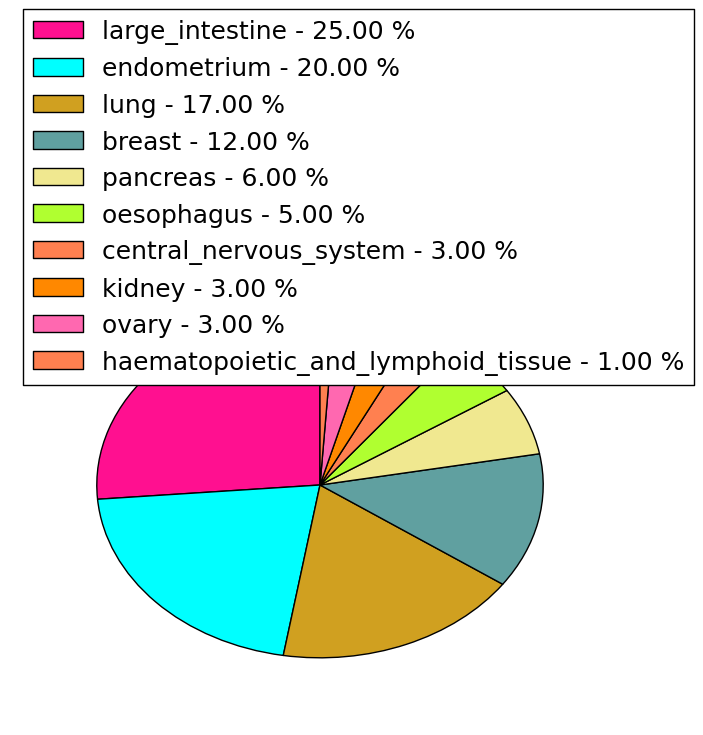 | 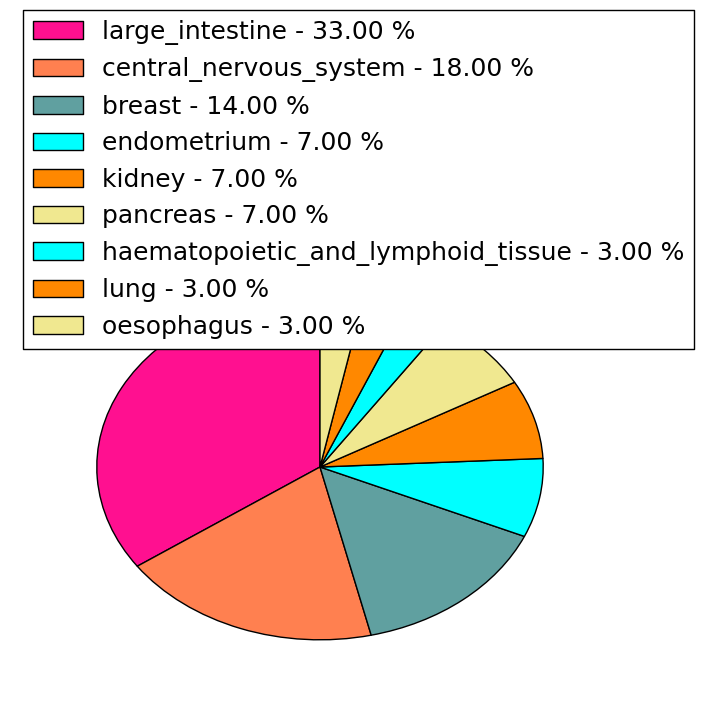 |
(# total SNVs=2) | (# total SNVs=0) |
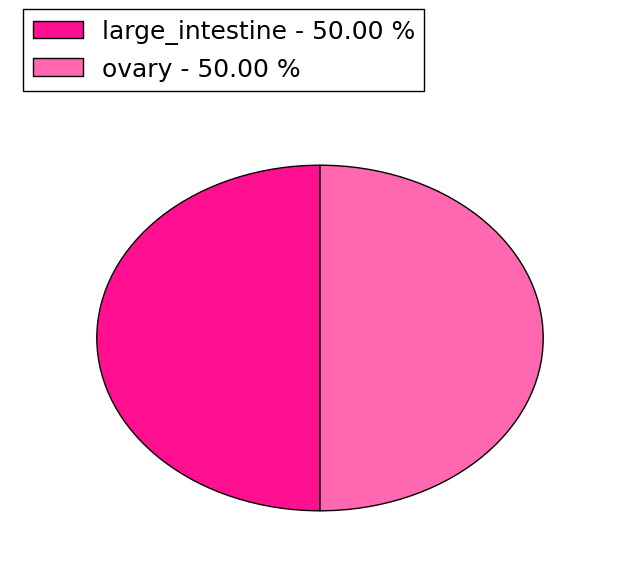 |
| Top |
| * When you move the cursor on each content, you can see more deailed mutation information on the Tooltip. Those are primary_site,primary_histology,mutation(aa),pubmedID. |
| GRCh37 position | Mutation(aa) | Unique sampleID count |
| chr5:179740827-179740827 | p.I471V | 3 |
| chr5:179731922-179731922 | p.T564T | 2 |
| chr5:179751867-179751867 | p.R209W | 2 |
| chr5:179734200-179734200 | p.Y550Y | 2 |
| chr5:179765502-179765502 | p.D36N | 2 |
| chr5:179731781-179731781 | p.T611T | 2 |
| chr5:179731784-179731784 | p.V610V | 2 |
| chr5:179745905-179745905 | p.I282I | 2 |
| chr5:179745923-179745923 | p.F276F | 2 |
| chr5:179743769-179743769 | p.V383M | 2 |
| Top |
|
 |
| Point Mutation/ Tissue ID | 1 | 2 | 3 | 4 | 5 | 6 | 7 | 8 | 9 | 10 | 11 | 12 | 13 | 14 | 15 | 16 | 17 | 18 | 19 | 20 |
| # sample | 2 | 5 | 1 | 15 | 1 | 4 | 2 | 1 | 10 | 4 | 1 | 12 | 7 | 10 | ||||||
| # mutation | 2 | 5 | 1 | 15 | 2 | 4 | 2 | 1 | 10 | 4 | 1 | 14 | 7 | 12 | ||||||
| nonsynonymous SNV | 1 | 3 | 1 | 9 | 2 | 2 | 8 | 3 | 1 | 5 | 4 | 10 | ||||||||
| synonymous SNV | 1 | 2 | 6 | 2 | 2 | 1 | 2 | 1 | 9 | 3 | 2 |
| cf) Tissue ID; Tissue type (1; BLCA[Bladder Urothelial Carcinoma], 2; BRCA[Breast invasive carcinoma], 3; CESC[Cervical squamous cell carcinoma and endocervical adenocarcinoma], 4; COAD[Colon adenocarcinoma], 5; GBM[Glioblastoma multiforme], 6; Glioma Low Grade, 7; HNSC[Head and Neck squamous cell carcinoma], 8; KICH[Kidney Chromophobe], 9; KIRC[Kidney renal clear cell carcinoma], 10; KIRP[Kidney renal papillary cell carcinoma], 11; LAML[Acute Myeloid Leukemia], 12; LUAD[Lung adenocarcinoma], 13; LUSC[Lung squamous cell carcinoma], 14; OV[Ovarian serous cystadenocarcinoma ], 15; PAAD[Pancreatic adenocarcinoma], 16; PRAD[Prostate adenocarcinoma], 17; SKCM[Skin Cutaneous Melanoma], 18:STAD[Stomach adenocarcinoma], 19:THCA[Thyroid carcinoma], 20:UCEC[Uterine Corpus Endometrial Carcinoma]) |
| Top |
| * We represented just top 10 SNVs. When you move the cursor on each content, you can see more deailed mutation information on the Tooltip. Those are primary_site, primary_histology, mutation(aa), pubmedID. |
| Genomic Position | Mutation(aa) | Unique sampleID count |
| chr5:179743769 | p.V383M | 2 |
| chr5:179745905 | p.E48K | 2 |
| chr5:179763551 | p.I282I | 2 |
| chr5:179731784 | p.Y667D | 1 |
| chr5:179744010 | p.T564T | 1 |
| chr5:179765551 | p.F420F | 1 |
| chr5:179739455 | p.F276F | 1 |
| chr5:179751868 | p.N113I | 1 |
| chr5:179728600 | p.F659F | 1 |
| chr5:179740938 | p.M544L | 1 |
| * Copy number data were extracted from TCGA using R package TCGA-Assembler. The URLs of all public data files on TCGA DCC data server were gathered on Jan-05-2015. Function ProcessCNAData in TCGA-Assembler package was used to obtain gene-level copy number value which is calculated as the average copy number of the genomic region of a gene. |
 |
| cf) Tissue ID[Tissue type]: BLCA[Bladder Urothelial Carcinoma], BRCA[Breast invasive carcinoma], CESC[Cervical squamous cell carcinoma and endocervical adenocarcinoma], COAD[Colon adenocarcinoma], GBM[Glioblastoma multiforme], Glioma Low Grade, HNSC[Head and Neck squamous cell carcinoma], KICH[Kidney Chromophobe], KIRC[Kidney renal clear cell carcinoma], KIRP[Kidney renal papillary cell carcinoma], LAML[Acute Myeloid Leukemia], LUAD[Lung adenocarcinoma], LUSC[Lung squamous cell carcinoma], OV[Ovarian serous cystadenocarcinoma ], PAAD[Pancreatic adenocarcinoma], PRAD[Prostate adenocarcinoma], SKCM[Skin Cutaneous Melanoma], STAD[Stomach adenocarcinoma], THCA[Thyroid carcinoma], UCEC[Uterine Corpus Endometrial Carcinoma] |
| Top |
| Gene Expression for GFPT2 |
| * CCLE gene expression data were extracted from CCLE_Expression_Entrez_2012-10-18.res: Gene-centric RMA-normalized mRNA expression data. |
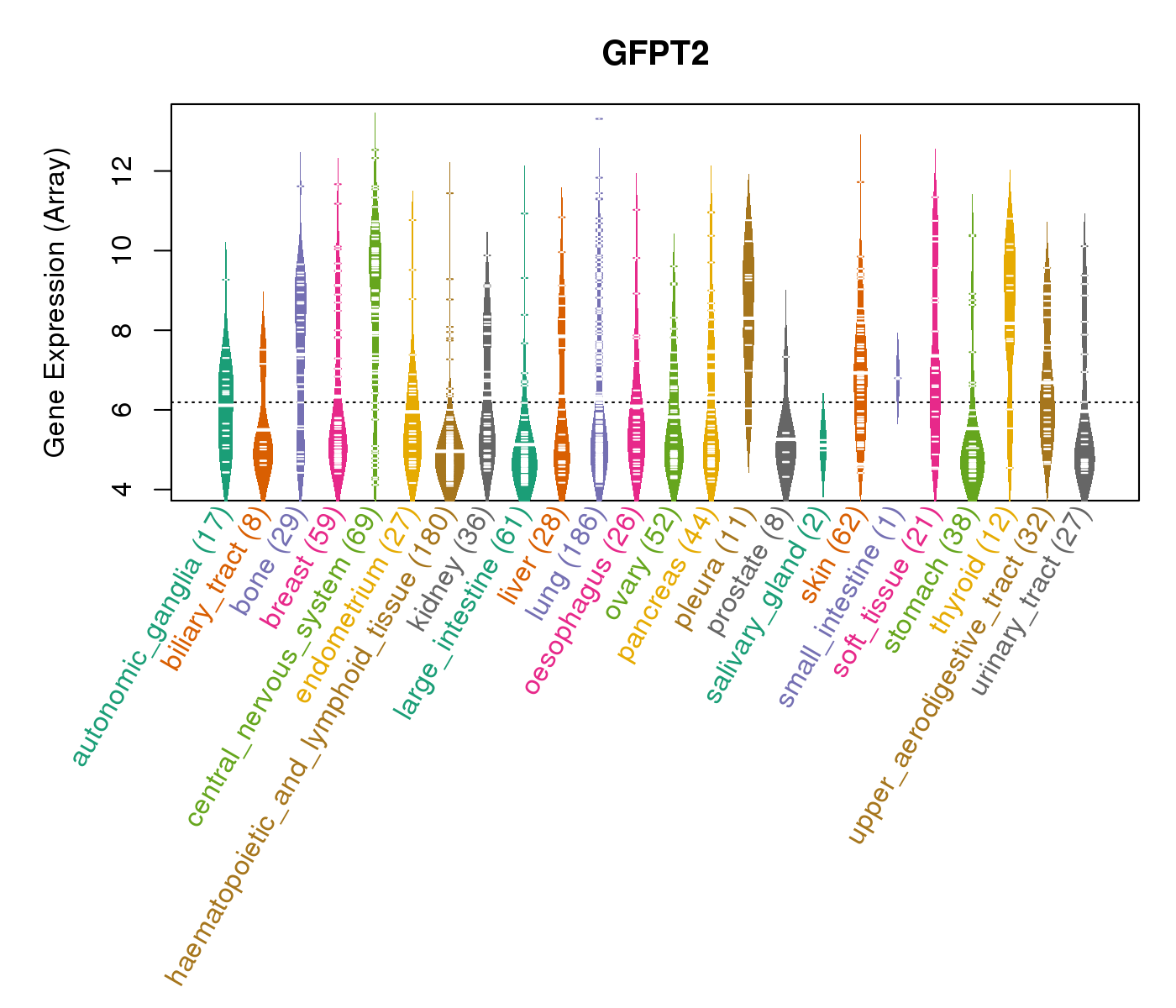 |
| * Normalized gene expression data of RNASeqV2 was extracted from TCGA using R package TCGA-Assembler. The URLs of all public data files on TCGA DCC data server were gathered at Jan-05-2015. Only eight cancer types have enough normal control samples for differential expression analysis. (t test, adjusted p<0.05 (using Benjamini-Hochberg FDR)) |
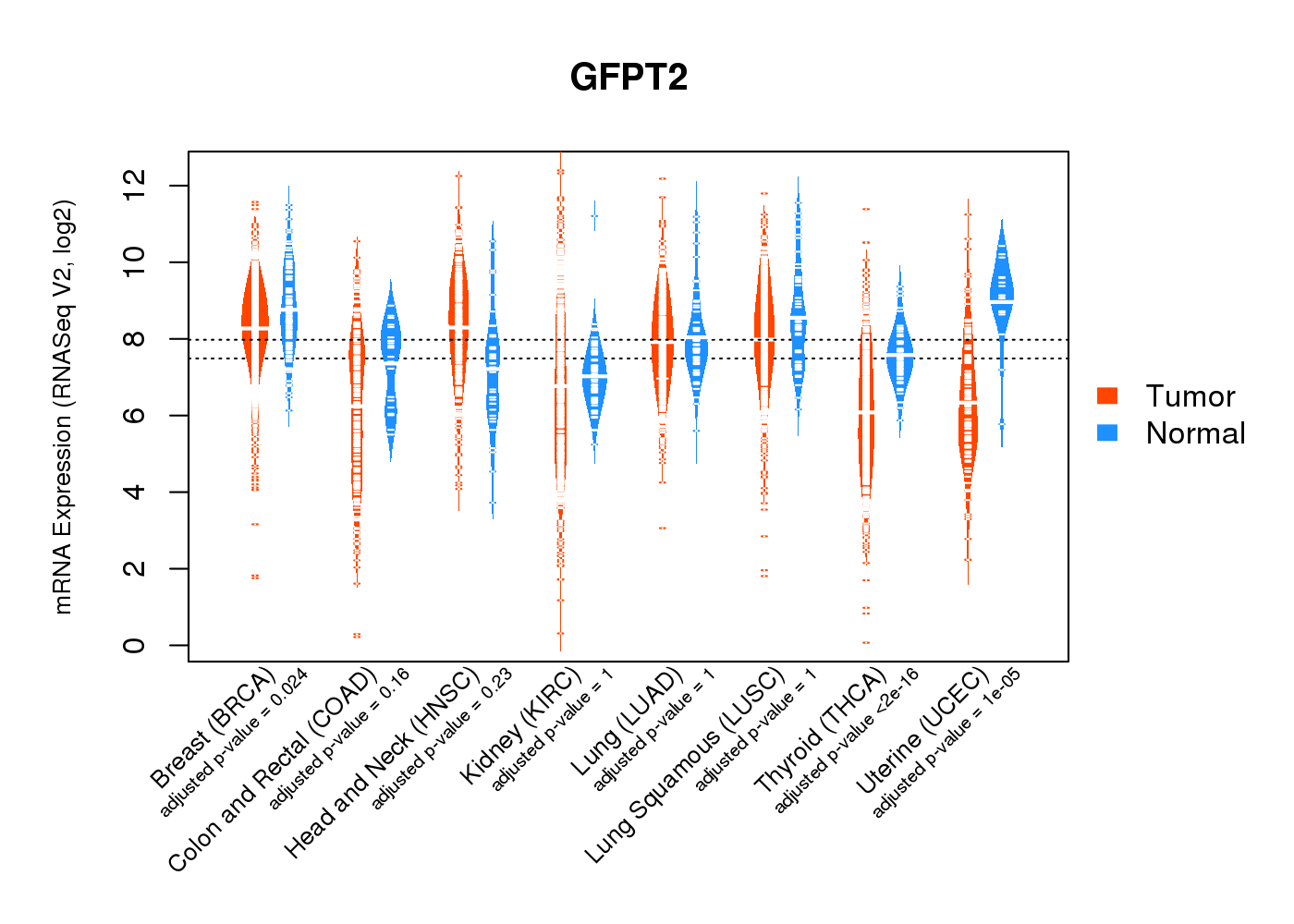 |
| Top |
| * This plots show the correlation between CNV and gene expression. |
: Open all plots for all cancer types
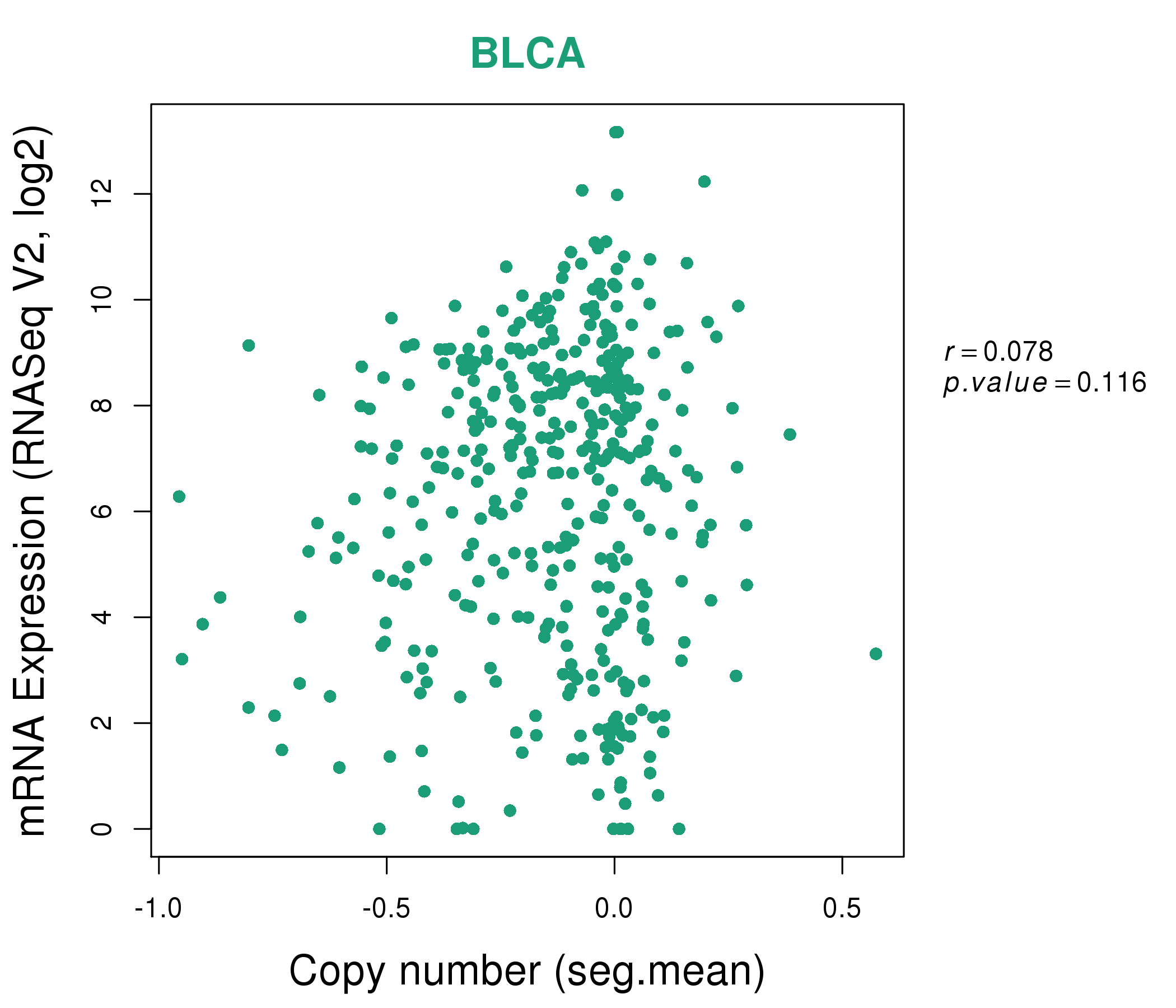 |
|
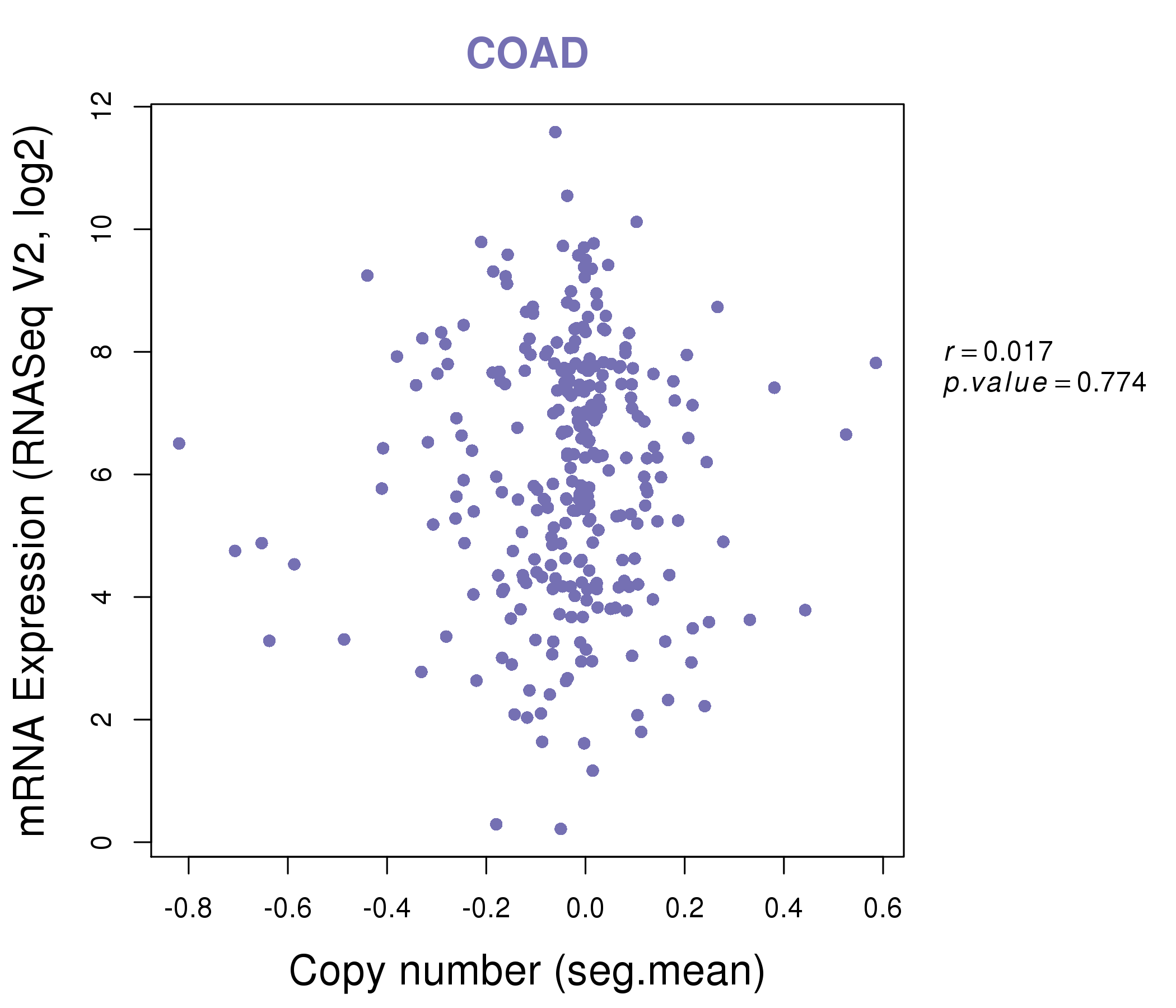 |
|
| Top |
| Gene-Gene Network Information |
| * Co-Expression network figures were drawn using R package igraph. Only the top 20 genes with the highest correlations were shown. Red circle: input gene, orange circle: cell metabolism gene, sky circle: other gene |
: Open all plots for all cancer types
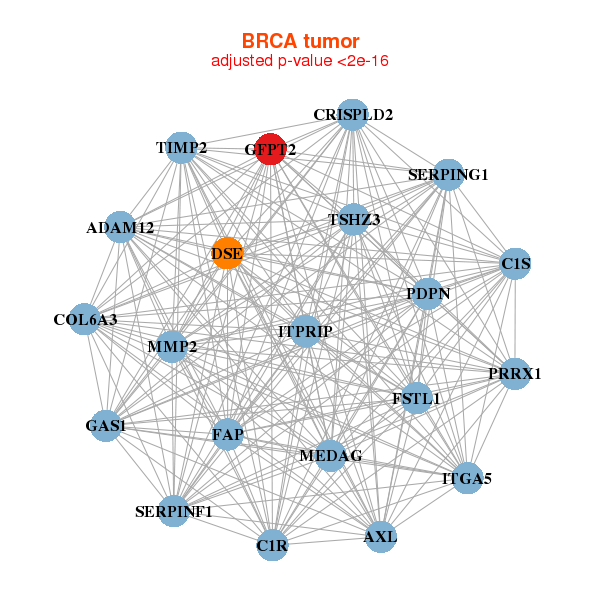 |
|
| ADAM12,AXL,MEDAG,C1R,C1S,COL6A3,CRISPLD2, DSE,FAP,FSTL1,GAS1,GFPT2,ITGA5,ITPRIP, MMP2,PDPN,PRRX1,SERPINF1,SERPING1,TIMP2,TSHZ3 | AXL,MEDAG,CILP,ACKR3,DNM1,FBN1,FSTL1, GAS7,GFPT2,GPR1,GPR133,HRH1,ITGB3,LMX1A, MFAP5,PROCR,PTGIS,SCARA5,SPSB4,WNT10B,XPNPEP2 |
 |
|
| ADAM12,CLMP,COL15A1,COL1A1,COL3A1,COL5A2,COL8A1, FBN1,GAS1,GFPT2,GPR176,HHIPL1,HRH2,HTR2A, IL1R1,ITGA5,LOX,PCDHGA12,PXDN,WISP1,ZNF469 | ADAMTSL4,ARHGAP29,MEDAG,C1orf198,CADM3,CD248,CD34, CREB5,DDX19A,FAM43B,FBLN1,FSTL3,GFPT2,HTRA3, LATS2,MSX1,NPR1,RBMS1,STK32B,TIMP3,WTIP |
| * Co-Expression network figures were drawn using R package igraph. Only the top 20 genes with the highest correlations were shown. Red circle: input gene, orange circle: cell metabolism gene, sky circle: other gene |
: Open all plots for all cancer types
| Top |
: Open all interacting genes' information including KEGG pathway for all interacting genes from DAVID
| Top |
| Pharmacological Information for GFPT2 |
| There's no related Drug. |
| Top |
| Cross referenced IDs for GFPT2 |
| * We obtained these cross-references from Uniprot database. It covers 150 different DBs, 18 categories. http://www.uniprot.org/help/cross_references_section |
: Open all cross reference information
|
Copyright © 2016-Present - The Univsersity of Texas Health Science Center at Houston @ |






